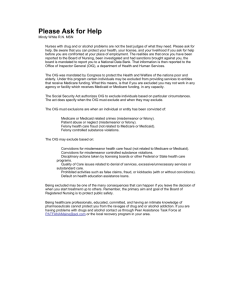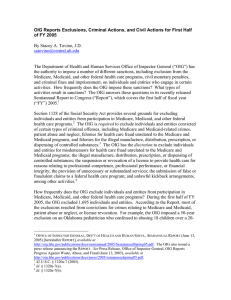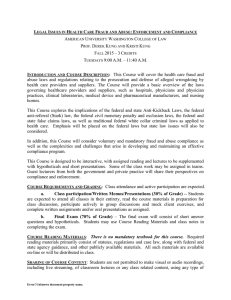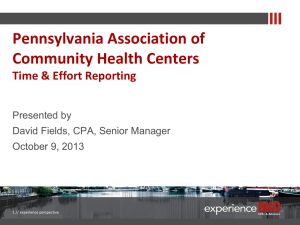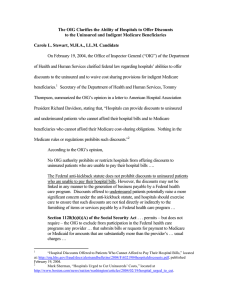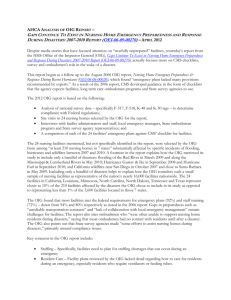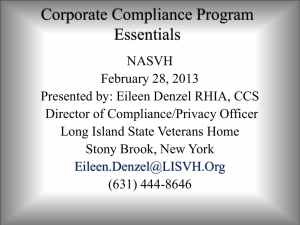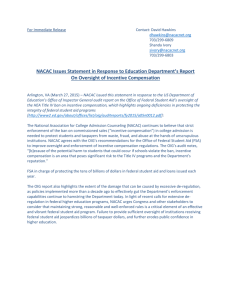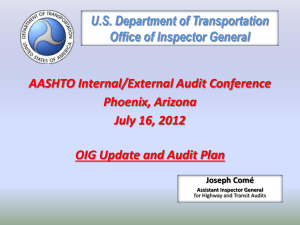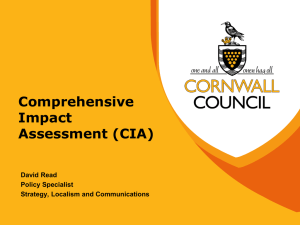September 2013 - Wolters Kluwer Law & Business News Center
advertisement
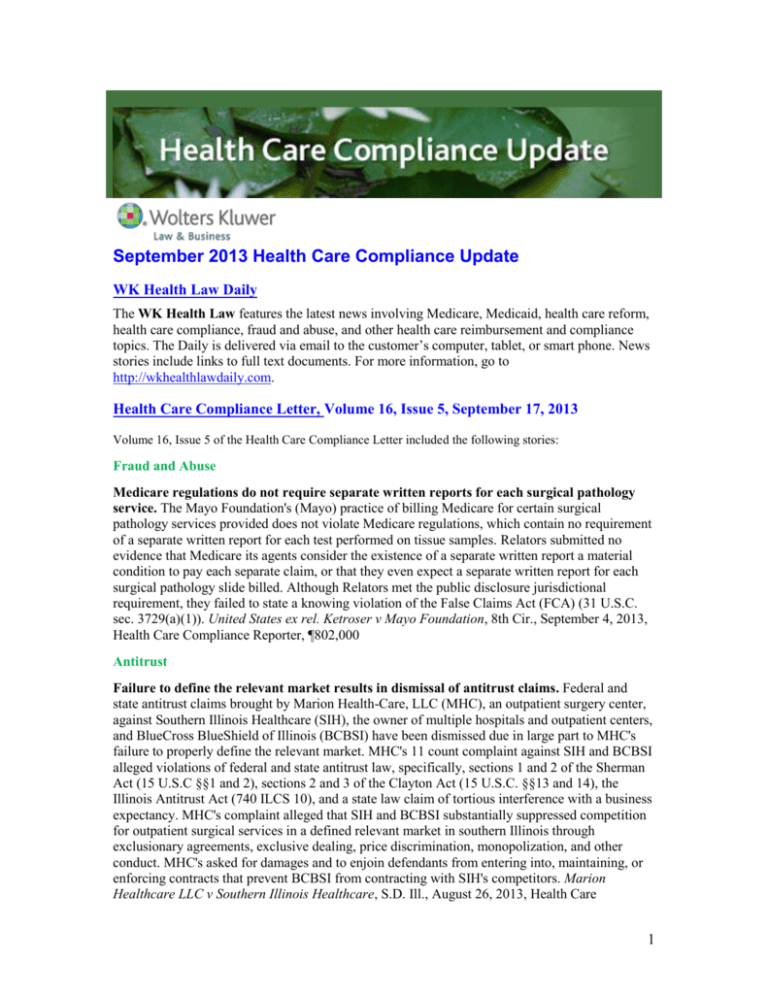
September 2013 Health Care Compliance Update WK Health Law Daily The WK Health Law features the latest news involving Medicare, Medicaid, health care reform, health care compliance, fraud and abuse, and other health care reimbursement and compliance topics. The Daily is delivered via email to the customer’s computer, tablet, or smart phone. News stories include links to full text documents. For more information, go to http://wkhealthlawdaily.com. Health Care Compliance Letter, Volume 16, Issue 5, September 17, 2013 Volume 16, Issue 5 of the Health Care Compliance Letter included the following stories: Fraud and Abuse Medicare regulations do not require separate written reports for each surgical pathology service. The Mayo Foundation's (Mayo) practice of billing Medicare for certain surgical pathology services provided does not violate Medicare regulations, which contain no requirement of a separate written report for each test performed on tissue samples. Relators submitted no evidence that Medicare its agents consider the existence of a separate written report a material condition to pay each separate claim, or that they even expect a separate written report for each surgical pathology slide billed. Although Relators met the public disclosure jurisdictional requirement, they failed to state a knowing violation of the False Claims Act (FCA) (31 U.S.C. sec. 3729(a)(1)). United States ex rel. Ketroser v Mayo Foundation, 8th Cir., September 4, 2013, Health Care Compliance Reporter, ¶802,000 Antitrust Failure to define the relevant market results in dismissal of antitrust claims. Federal and state antitrust claims brought by Marion Health-Care, LLC (MHC), an outpatient surgery center, against Southern Illinois Healthcare (SIH), the owner of multiple hospitals and outpatient centers, and BlueCross BlueShield of Illinois (BCBSI) have been dismissed due in large part to MHC's failure to properly define the relevant market. MHC's 11 count complaint against SIH and BCBSI alleged violations of federal and state antitrust law, specifically, sections 1 and 2 of the Sherman Act (15 U.S.C §§1 and 2), sections 2 and 3 of the Clayton Act (15 U.S.C. §§13 and 14), the Illinois Antitrust Act (740 ILCS 10), and a state law claim of tortious interference with a business expectancy. MHC's complaint alleged that SIH and BCBSI substantially suppressed competition for outpatient surgical services in a defined relevant market in southern Illinois through exclusionary agreements, exclusive dealing, price discrimination, monopolization, and other conduct. MHC's asked for damages and to enjoin defendants from entering into, maintaining, or enforcing contracts that prevent BCBSI from contracting with SIH's competitors. Marion Healthcare LLC v Southern Illinois Healthcare, S.D. Ill., August 26, 2013, Health Care 1 Compliance Reporter, ¶801,991 EMTALA An ER doctor cannot maintain his claims that he was discharged for complaining about overcrowding. Affirming a district court's grant of summary judgment to a hospital and its administrator, the Tenth Circuit ruled that although an emergency room doctor may likely have made his complaints based on good intentions, he could not maintain his claims that the defendants violated the Emergency Medical Treatment and Active Labor Act (EMTALA) or state law. Regardless of how he approached the EMTALA claim, the doctor failed to establish that he was entitled to relief under that statute. Additionally, he expressly waived his right to sue the hospital for any state law claims when he signed an agreement directly with the hospital. Genova v Banner Health, 10th Cir., August 20, 2013, Health Care Compliance Reporter, ¶801,983 Antikickback Medigap insurer's proposed network hospital savings and premium credits acceptable. The Office of Inspector General (OIG) concluded that a proposed arrangement for a supplier (Requestor) of Medicare Supplemental Health Insurance (Medigap) policies to contract with hospitals, giving deductible savings to the Requestor and returning savings to certain policyholders in the form of premium credits presents sufficiently low risk of fraud or abuse. Under the proposal, which would apply to all policyholders of the Requestor's Medigap plans that cover Part A deductibles, the Requestor would enter into contractual arrangements with one or more preferred provider organizations (PPOs) with a network of hospitals throughout the country (Network Hospitals). The premium credits under the proposed arrangement, which would be offered to induce policyholders to select a Network Hospital from a broader group of eligible providers, falls within the prohibition against transferring remuneration. There is, however, an exception for differentials in coinsurance and deductible amounts as part of a benefit plan design as long as the differentials are properly disclosed to affected parties and meet certain other applicable requirements (Soc. Sec. Act §1128A(i)(6)(C)). Although the proposed arrangement is a straightforward agreement by the Network Hospitals to discount the Medicare inpatient deductible for the Requestor's policyholders, an amount for which the Requestor otherwise would be liable, OIG determined that the proposed arrangement presents a sufficiently low risk of fraud or abuse under the anti-kickback statute because neither the discounts nor the premium credits would increase or affect per-service Medicare payments, and the proposed arrangement would be unlikely to increase utilization, unfairly affect competition among hospitals, or affect professional medical judgment. OIG Advisory Opinion, No. 13-12, August 27, 2013, Health Care Compliance Reporter, ¶500,309 Discharge monitoring program at low-risk of anti-kickback violations. The proposed arrangement between a wholly owned subsidiary of a pharmaceutical company (subsidiary) and hospitals wherein the subsidiary would provide services intended to help patients follow their discharge plans and reduce hospital readmissions has a low risk of fraud and abuse under the antikickback statute. Under the proposal the subsidiary would sell a package of services to hospitals to help them avoid payment reductions associated with excess hospital readmissions. The services would be available to patients who were hospitalized with one of the conditions set forth in the Hospital Readmission Reduction Program (HRRP). Patients eligible for the services provided by the subsidiary would be identified by the hospital's discharge nurse. Discharge planning would be taken over by software provided to the hospital by the subsidiary. The Office of Inspector General (OIG) determined that the proposal is unlikely to (1) lead to increased costs or overutilization of federally reimbursable services, (2) interfere with clinical decision-making; and (3) result in patient steering; and includes a number of safeguards to ensure that the proposal is not used to increase drug sales of the parent pharmaceutical company. The services are designed to promote 2 adherence to all medications regardless of the manufacturer. In addition, no reward or incentive is provided that would likely influence the selection of a provider, practitioner, or supplier. OIG Advisory Opinion, No. 13-10, August 9, 2013, Health Care Compliance Reporter, ¶500,307 Township's proposed cost sharing arrangements for volunteer EMS services acceptable. A township's two proposed cost sharing arrangements involving emergency medical services (such as ambulance rides) from a volunteer department would not lead to administrative sanctions under anti-kickback prohibitions. The volunteer first aid squad is the only supplier of basic life service (BLS) ambulance services in the township, and the emergency services are currently free of charge. "Proposal A" would allow the BLS supplier to begin billing for emergency ambulance services for everyone except bona fide township residents. The township would use tax revenue to make an annual donation to the BLS supplier for an amount estimated to be close to the actual cost of services. As proposed, the OIG determined it would not impose administrative sanctions under the Anti-Kickback Statute because the resident's tax revenues would finance the payment to the BLS supplier, covering the resident's uncollected cost-sharing obligations. "Proposal B" would be insurance only billing with a waiver of applicable cost-sharing obligations when providing back up emergency ambulance services for residents of towns receiving mutual aid emergency ambulance assistance. The EMS services would be free of charge to the individuals, but their insurance would be billed. For similar reasons, the OIG determined the proposal does not involve a routine waiver of cost-sharing obligations because the services are sporadic. There is little chance of increased cost to the federal health care programs with this proposal. OIG Advisory Opinion, No. 13-11, August 21, 2013, Health Care Compliance Reporter, ¶500,308 On the Front Lines Learning from the Past and Building for the Future: Corporate Integrity Agreements in the Life Sciences Industry, Part II: Commonalities and Trends in Corporate Integrity Agreements (excerpt) by Jeffrey B. Miller, Esq. and Paige P. Slater As noted in Part I of this article, there are many ways to achieve effective compliance, and no single way is required by law. Studying the Department of Health and Human Services, Office of Inspector General (OIG) Corporate Integrity Agreements (CIAs), however, providers and organizations in the life sciences industry can discern current OIG requirements, as well as trends in the establishment and development of compliance program controls, anticipating OIG's standards of the future. By anticipating OIG's future standards, with the past as prologue, providers and organizations can better develop their programs for effective future compliance. The goals for this study were to understand OIG's current requirements for effective compliance programs as reflected in CIAs, and to identify trends in CIA requirements that may indicate potential future OIG expectations for the life sciences industry. To achieve these goals this study included review of 42 life sciences industry CIAs, from the Medicis Pharmaceuticals CIA issued in April, 2007 through the Amgen CIA issued in December, 2012. Both pharmaceutical and medical device industry CIA's were reviewed, including 26 pharmaceutical CIAs and 16 medical device CIAs. For point of comparison, three of the earliest settlement and integrity agreements ever issued by OIG - National Medical Enterprises, Inc. in June, 1994, T2 Medical, Inc. in September, 1994, and Radiation Care, Inc. in December, 1994, were also reviewed. Each CIA was analyzed for its major elements, both structural and substantive, with a particular attention paid to elements that were added or changed over time. For purposes of analysis, the elements reviewed were then broken out and charted for each CIA vis a vis the others, and compared by CIA effective date, by industry (pharmaceutical v. medical device), by violation(s) resulting in the CIAs (FDCA v. AKS), and by fines assessed. Jeffrey B. Miller is Vice President, Global Synthes CIA Compliance Officer and Group Leader with DePuy Synthes, Companies of Johnson & Johnson. 3 Journal of Health Care Compliance The September/October issue of the Journal of Health Care Compliance mailed to subscribers on September 9, 2013, and is available on Intelliconnect. The issue included the following articles: COLUMNS From the Editor—Roy Snell The Current Value of a Law Degree Electronic Resources—Catherine M. Boerner HCCA Posts More Than 80 Best Practices Videos on Web Site Best Practices—Julene Brown LTC Facilities that Provide Services through a Medicare-certified Hospice Must Have a Signed Agreement Detailing Services to Be Provided Hospital Compliance—David Centafont No Good Deed Goes Unpunished Patient Safety—Reba L. Kieke Study Examines Top Priorities of Hospital C-Suite Executives and Risk Managers Tax Implications—Ralph Levy, Jr. Beware of the Tax Consequences of Physician Recruitment Payment Government Contractor Compliance—Linda Martin Comparing and Contrasting the Role of a Provider Compliance Officer with the Role of a MAC Compliance Officer Meaningful Use—David Nilasena What You Need to Know about Pre- and Post-payment EHR Audits Health Information Management—Angela Dinh Rose The Final Omnibus Rule: Compliance Is Coming — Are You Ready? Privacy—Lori J. Strauss Patient Privacy Impacts Quality Lab—Christopher Young Updated Effects of Exclusion May Impact Laboratories More than Others Settlements— Esther H. Yu HIPAA Privacy and Security: Analysis of Recent Enforcement Actions FEATURES Valerie A. Rinkle / Catherine M. Boerner ICD-10 and Compliance — Joined at the Right Hip 0SG90ZZ? Richard E. Moses / D. Scott Jones PPACA Quality Reporting for 2014 and Beyond: Quality-Based Physician Fee Schedule Reductions Cornelia M. Dorfschmid / Steven D. Forman Meeting the Challenge of Adequately Addressing Numerous Compliance Risks William Schurgin / Kyle Hartman Military Leave Law — The Rights & Obligations of Returning Veterans Richard P. Kusserow The Prescription Drug Epidemic: Another Compliance High-risk Area FOR THE RECORD Roy Snell Have You Ever Said or Felt One of the Following in Your Time as a Compliance Officer? 4 Health Care Compliance Professional’s Manual The Health Care Compliance Professional’s Manual quarterly report mailed to subscribers on September 17, 2013, and became available to electronic subscribers on September 24. Report 38 included the following new and revised chapters: “The Ever-Changing Legal and Compliance Landscape of Suppliers of Durable Medical Equipment, Orthotics, Prosthetic and Supplies,” written by Jana Kolarik Anderson, Esq., a partner resident in Nelson Mullins Riley & Scarborough LLP's Jacksonville, Florida, office, defines DMEPOS and discusses billing, coverage, standards, pricing, competitive bidding, and documentation as well as the compliance issues affecting suppliers of DMEPOS. “The Federal Physician Payments Sunshine Act: The Rules and Impact on Life Science Manufacturers,” written by Kelly N. Reeves, a partner, and Brian Bohnenkamp and Ami Patel, associates in King & Spalding’s FDA & Life Sciences practice in Washington, D.C., provides an overview of the Sunshine Act and the obligations it imposes on life sciences manufacturers and group purchasing organizations. “Overview of the Office of Inspector General” has been updated by Arianne Callender, Senior Counsel for Global Commercial Operations at Amgen Inc., to eliminate obsolete information and provide updated information in light of the Patient Protection and Affordable Care Act (PPACA), including the Physician Payments Sunshine Law and the establishment of permanent yearly increases to the Health Care Fraud and Abuse Control Program. “Evaluating the Compliance Professional” has been updated by Lynda Hilliard, MBA, RN, CHC, CCEP, the University of California (UC) System-wide Deputy Compliance Officer and UC Office of the President Ethics and Compliance Officer, to include current thinking on evaluating a compliance officer as well as strategies and tools and the use of outside consultants as evaluators. “Integrating Ethics into a Compliance Program” has been reviewed by Al Josephs, Senior Director Policies and Training for Tenet's Ethics and Compliance program in Dallas, Texas, to ensure that the material presented in the chapter is current. 5
